
Dendermonde is a city in the Flemish province of East Flanders in Belgium. The municipality comprises the city of Dendermonde and the towns of Appels, Baasrode, Grembergen, Mespelare, Oudegem, Schoonaarde, and Sint-Gillis-bij-Dendermonde. Dendermonde is at the mouth of the river Dender, where it flows into the Scheldt. The town has a long-standing folkloric feud with Aalst, south along the same river, which dates from the Middle Ages.

Sint-Niklaas is a Belgian city and municipality located in the Flemish province of East Flanders. The municipality comprises the city of Sint-Niklaas proper and the towns of Belsele, Nieuwkerken-Waas, and Sinaai.
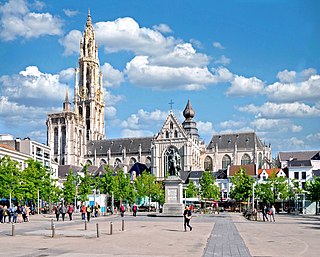
The Cathedral of Our Lady is a Roman Catholic cathedral in Antwerp, Belgium. Today's seat of the Diocese of Antwerp started in 1352 and, although the first stage of construction was ended in 1521, has never been 'completed'. It was constructed in the Gothic style by architects Jan and Pieter Appelmans. It contains a number of significant works by the Baroque painter Peter Paul Rubens, as well as paintings by artists such as Otto van Veen, Jacob de Backer and Marten de Vos. The cathedral is the largest Gothic church in Belgium, with its tower rising 123 meters over the city.

The Virga Jesse Basilica is a basilica located on Kapelstraat in Hasselt, Belgium. The church is best known for housing the 14th-century statue of the Virga Jesse, which is paraded through the streets of Hasselt every seven years during the Seven-Yearly Festivities.

The Church of Our Lady is a Roman Catholic church in Bruges, Belgium, dating mainly from the 13th, 14th and 15th centuries. Its 115.6-metre-high (379 ft) tower remains the tallest structure in the city and the third tallest brickwork tower in the world.

Melsele is a town in the Belgian province of East Flanders, between the city of Beveren and the nearby town of Zwijndrecht. Tram route 3 which starts just outside the town connects it to Zwijndrecht and Antwerp. The town's road links include the E17 and the E34.

The Church of Our Lady is a former collegiate church located in the centre of Kortrijk, Belgium. It was built and established by Baldwin IX, Count of Flanders in 1199.

André Beauneveu was an Early Netherlandish sculptor and painter, born in the County of Hainaut, who is best known for his work in the service of the French King Charles V, and of the Valois Duke, Jean de Berry. His work in all media shows a generally naturalistic and 'sculptural' style, characteristic of the 'Pucellian revival' of the latter 14th century.

The Vrouwekerk or Vrouwenkerk, originally known as the Onze-Lieve-Vrouwekerk, was a 14th-century church in the Dutch city of Leiden. In the early 17th century, the church was attended by the Pilgrims as well as by the first colonists to settle on Manhattan.

Kortrijk, sometimes known in English as Courtrai or Courtray, is a Belgian city and municipality in the Flemish province of West Flanders.
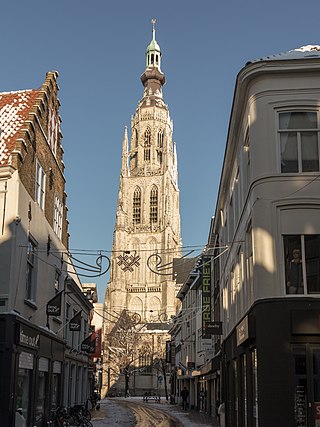
The Grote Kerk or Onze-Lieve-Vrouwekerk is the most important monument and a landmark of Breda. The church is built in the Brabantine Gothic style. The tower of the church is 97 meters tall. The plan is in the shape of a Latin Cross.
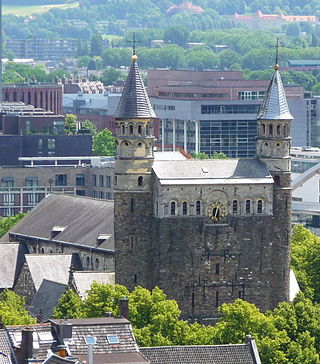
The Basilica of Our Lady is a Romanesque church in the historic center of Maastricht, Netherlands. The church is dedicated to Our Lady of the Assumption and is a Roman Catholic parish church in the Diocese of Roermond. The church is often referred to as the Star of the Sea, after the church's main devotion, Our Lady, Star of the Sea.

Binnenstad is a neighbourhood in Maastricht, Netherlands. Until 2007, it was officially named City. As its name suggests, it is the most centrally located area of Maastricht.

The Church of Our Lady of Victories at the Sablon, or the Church of Our Lady of the Sablon, is a Catholic church located in the Sablon/Zavel district, in the historic centre of Brussels, Belgium. It is dedicated to Our Lady of the Sablon.

Ter Doest Abbey was a Cistercian abbey in Belgium, in the present Lissewege, a district of Bruges, West Flanders.
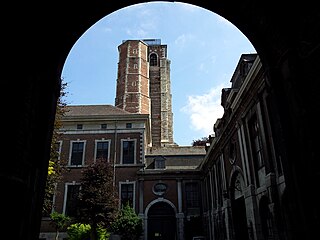
Sint-Truiden Abbey or St Trudo's Abbey is a former Benedictine monastery in Sint-Truiden in the province of Limburg, Belgium. The abbey was founded in the 7th century and was one of the oldest and most powerful in the Low Countries. The town of Sint-Truiden grew up around it. The great Romanesque abbey church, dedicated to Saint Remaclus and Saint Quintin, was demolished in 1798, four years after the suppression of the abbey.
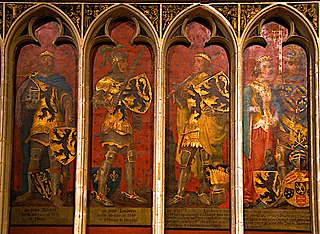
Jan van der Asselt or Jan van der Hasselt was a Flemish painter.

Wortegem is a village and seat of the municipality of Wortegem-Petegem in the Belgian province of East Flanders. It is located about 17 kilometres (11 mi) east of Kortrijk.

The Onze Lieve-Vrouwekapel in Echt is a 17-century chapel in Schilberg, a hamlet between Pey and Echt in the Dutch province of Limburg. The chapel was declared a national monument. It is a pilgrimage site for the celebration of the Nativity of Mary.





















